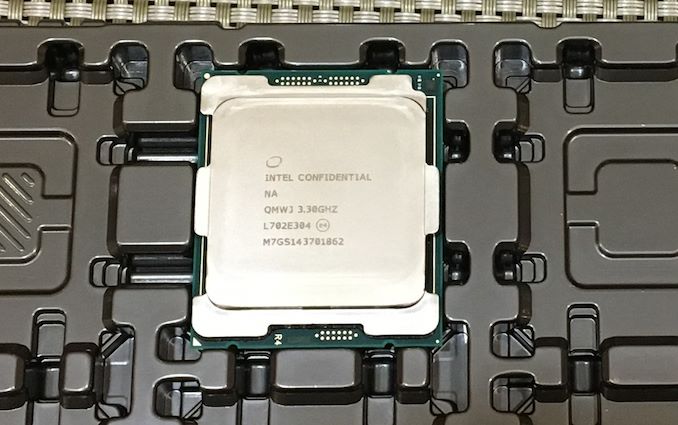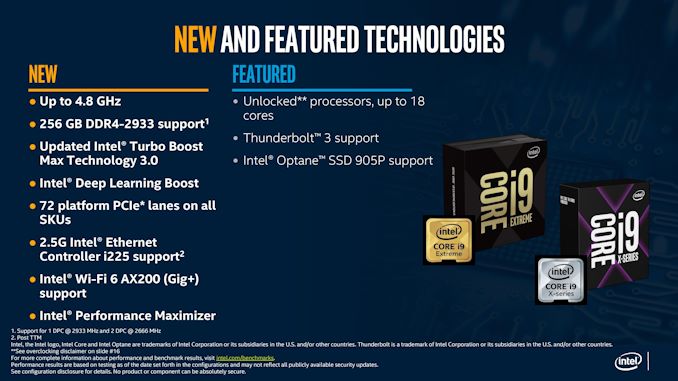Intel's Cascade Lake-X CPU for High-End Desktops: 18 cores for Under $1000
by Dr. Ian Cutress on October 1, 2019 6:35 PM EST- Posted in
- CPUs
- Intel
- HEDT
- LGA2066
- Cascade Lake

With someone in the press having broken their embargo earlier today, Intel is lifting the lid earlier than planned on their upcoming Cascade Lake-X family of processors for the high-end desktop (HEDT) market. Similar to the way Intel's Cascade Lake based Xeon Scalable processors are a further revision of their Skylake Xeons, offering clock speed increases and security fixes in hardware, the new HEDT processors will grant higher frequencies, more memory capacity, and better protection against side-channel attacks. The key numbers however are the big drop in Intel's pricing: Intel will be releasing its 18-core part, the Core i9-10980XE, for under $1000.
| Intel Cascade Lake-X | |||||||
| AnandTech | Cores Threads |
Base | All Core |
TB2 | TB3 | TDP | Price (1ku) |
| Core i9-10980XE | 18C / 36T | 3.0 | 3.8 | 4.6 | 4.8 | 165 W | $979 |
| Core i9-10940X | 14C / 28T | 3.3 | 4.1 | 4.6 | 4.8 | 165 W | $784 |
| Core i9-10920X | 12C / 24T | 3.5 | 4.3 | 4.6 | 4.8 | 165 W | $689 |
| Core i9-10900X | 10C / 20T | 3.7 | 4.3 | 4.5 | 4.7 | 165 W | $590 |
| Skylake-X (previous generation) | |||||||
| Core i9-9980XE | 18C / 36T | 3.0 | 4.5 | 4.7 | 165 W | $1979 | |
| Core i9-9940X | 14C / 28C | 3.3 | 4.5 | 165 W | $1387 | ||
| Core i9-9920X | 12C / 24T | 3.5 | 4.5 | 165 W | $1189 | ||
| Core i9-9900X | 10C / 20T | 3.5 | 4.5 | 165 W | $989 | ||
This pricing is a significant shift in Intel's strategy, and a number of fingers will be pointed at AMD as having made this happen. Next month AMD is set to launch its 16-core Ryzen 9 3950X at $749, which will offer 16 PCIe 4.0 lanes for slots (+4 for M.2, +4 for chipset) and support for 128 GB of DRAM. So Intel needed something similarly speedy, but with more PCIe lanes and more memory support that they could offer for just a bit more, leading to the 10980XE for $979. Ultimately, the on-shelf price is often just slightly higher than tray price, so don't be surprised if retail prices land at around $1000.
All the CPUs will support 256 GB of quad-channel memory (up from 128 GB), and have 48 PCIe 3.0 lanes (up from 44). Memory speed support is listed as DDR4-2933 for 1 DIMM per channel, and DDR4-2666 for 2 DIMMs per channel. All these CPUs have a TDP of 165 W, which Intel states will help the CPUs to turbo longer under Intel's recommended settings (as we know, consumer motherboard manufacturers like to ignore these anyway). All these CPUs are supported in X299 motherboards.
There is no 16-core in this stack, with Intel's official reasoning being that they assess the market with each generation and they don't believe there's a suitable price point for such a part when the 14C and 18C parts are so close. Most people will point the finger and say that no-16 core Intel part means no direct comparison with the Ryzen 9 3950X, which is something to think about.
Another point to note is that Intel has stopped this stack at the 10 core and no lower. This means that there will be no cross over between Intel's consumer processor stack and the HEDT stack, with users needing to spend just a little bit more from the Core i9-9900K/KF to reach up to the Core i9-10900X. It will be interesting to see where Intel's Core i9-9900KS fits in, although that still only has dual channel memory and 16 PCIe 3.0 lanes.
Intel lists Wi-Fi 6 and 2.5GbE support on these new processors - to clarify, Intel means external controllers here. For some odd reason when Intel says support, it could mean internal to the chipset or external via a controller; this is messaging I've railed against for a while, as it ends up confusing for enthusiasts, especially when this is an enthusiast platform. It does mean however that we get official information about Intel's 2.5GbE controllers, which we've been waiting on for a couple of years. Intel stated that these controllers will be ready at a later date, and more information to follow. (The controllers are currently listed on Intel's ARK database, but as 1 GbE controllers for some reason.)
These CPUs will have the same security mitigations as the Cascade Lake Xeon processors, with updated hardware mitigations for a number of side channel attacks. We are waiting to hear from Intel if the firmware that supports these processors will also have additional fixes in for Zombieload by default.
One question about this launch is surrounding Intel’s 14nm capacity. Within the last week, there have been reports that despite Intel’s best efforts and promises to match demand, and that Q3 and upcoming for Q4 is going to be busier than expected. We reached out to Intel last week for clarification, and the company said that the bulk of its capacity is focusing on the high-end processors in the market: the Xeon Scalable, the Core i9, Core i7, and Core i5. It will be interesting to see if launching another family of products is going to put additional strain on Intel’s capacity and demand.
With AMD's recent Zen 2 Ryzen 3000 series launch on 7nm earlier in the year, Threadripper 3 coming later this year, and Intel swinging another generation of 14++ into the high-end desktop market, Intel is going to have some tough times. Don't get me wrong, this pricing update from Intel is a good thing for users, especially those looking at implementing things like DL Boost to their workflow, but this market is suddenly turning very aggressive, and it will be interesting to see if Intel can be agile enough to keep pace.
Intel's Cascade Lake-X processors will be available in November. More details should be released nearer to launch.











162 Comments
View All Comments
eek2121 - Wednesday, October 2, 2019 - link
AMD's 16 core part is not a Threadripper part. People forget this. I suspect entry level Threadripper parts to creep up in price given their performance advantage, but we don't yet know with any certainty what the stack will look like. The 8 core Threadripper variant IIRC only carried a $100 price premium over it's Ryzen counterpart, however. That is worth noting.Mr.Vegas - Wednesday, October 2, 2019 - link
The 10 core Intel still has 48 CPU PCIe lanes + 24 on chipset.AVX512
Real Turbo boost [Lets be honest here, what AMD sells as single core turbo is nothing but a scam, when it clocks up for one second and drops down to its all core turbo it has no value, Intels Turbo performs properly, no such issues]
Real Overclocking
And what no less important for me, excellent emulator performance.
Now add to it that to this 3900x is sold for premium by scalpers and always out of stock, same thing going to happen with 3950x.
In this case Intels price vs AMD street price looks insanely better
eek2121 - Wednesday, October 2, 2019 - link
Threadripper has 64 PCIE lanes right from the CPU, not counting anything from the chipset. You have apparent bias against AMD so I'm tempted not to post, but I'll bite: What you say is false, single and dual core workloads have seen 4.6-4.7 GHz on many 3800X chips for example, some 3800X chips hit 4.7 GHz on all cores (as evidenced by GB4 JSON data.) The 3900X has some issues that needed to be worked out, but the ABBA AGESA release fixed many of those issues, and many users are hitting 4.7 GHz.Also, clock speed doesn't really matter as AMD trounces Intel in the majority of workloads anyway...hence the reason for the sudden price decrease above.
Korguz - Wednesday, October 2, 2019 - link
Mr.Vegasand lets be honest here, intels TDP rating is nothing but a scam, when a cpu is listed as using X watts, but under usage, can use 50-150 watts MORE, what do you call that ? " Intels Turbo performs properly, no such issues " providing the cooling is sufficient, maybe thats why intel doesnt include a cooler with its higher end parts.
" Real Overclocking " again IF cooling is sufficient.
" 3900x is sold for premium by scalpers and always out of stock " must be just where you are, as i have seen them in stock regularly at the local comp stores i go to.
" In this case Intels price vs AMD street price looks insanely better " not really, as you seem to forget, intels cpus dont come with a cooler, so add $50 + to the price for intels cpus.
jakky567 - Wednesday, October 2, 2019 - link
16 core consumer zen 2 presumably has the frequency and IPC advantage with equivalent cooling, except for turbo 3.0 vs single core boost. 3950x has higher single core compared to Intel HEDT though.YB1064 - Wednesday, October 2, 2019 - link
The 165 W TDP claimed seems rather low, if SkylakeX in-use measurements were anything to go by.psychobriggsy - Wednesday, October 2, 2019 - link
TDP for Intel is at base clocks. You'd best have a water cooler if you want decent long-lived turbo clocks with these processors.Marlin1975 - Tuesday, October 1, 2019 - link
And the winner is... consumers. Isn't competition a great thing. Still over priced and 165w seems low, unless thats using intels latest fake power ratings.Also "16-core Ryzen 9 3950X at $749, which will offer 16 PCIe 4.0 lanes" Is it losing 8 lanes? I thought they all had 24. 16 for GPU, 4 for m.2 storage, and 4 for the chip-set bridge.
Ian Cutress - Tuesday, October 1, 2019 - link
My bad, it's 16 for PCIe slots. 4 for storage, 4 for chipset. I pretty much always just count the PCIe lanes for slots (because that's what it used to mean)peevee - Thursday, October 3, 2019 - link
All X570 motherboards claim PCIE4 in 16+4 configuration on slots. I guess one of the M.2 slots is shared.